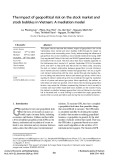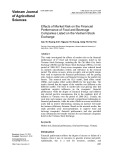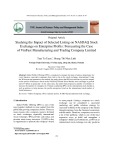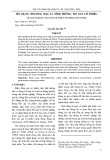
* Corresponding author Tel:+982173222005
E-mail address: mazdeh@iust.ac.ir (M. Mahdavi Mazdeh)
© 2020 by the authors; licensee Growing Science.
doi: 10.5267/j.uscm.2019.8.004
Uncertain Supply Chain Management 8 (2020) 77–92
Contents lists available at GrowingScience
Uncertain Supply Chain Management
homepage:
www.GrowingScience.com/uscm
Applying meta-heuristic algorithms for an integrated production-distribution problem in a two
level supply chain
Maedeh Banka, Mohammad Mahdavi Mazdeha* and Mahdi Heydaria
aDepartment of Industrial Engineering, Iran University of Science and Technology, Narmak, Tehran, Iran
C H R O N I C L E A B S T R A C T
Article history:
Received July 14, 2019
Received in revised format July
28, 2019
Accepted August 5 2019
Available online
August
5
2019
Supply Chain Management (SCM) is the set of approaches used for the appropriate integration
and utilization of suppliers, manufacturers, warehouses and retailers to ensure the production
and delivery of products to end users in the right quantities and at the right time. Integration of
the stages in the supply chain can make it more effective and profitable as a whole. In the
present study, an integrated production and distribution problem in a two-stage supply chain is
considered. The supply chain consists of m manufacturers with different locations and rates of
production, and a distributer that delivers the ordered products to customers in different
locations. Here, products are seasonal and perishable and must be delivered before a specified
time. To characterize the problem, a Mixed Integer Programming (MIP) model is proposed and
to solve the proposed model, a Hybrid Simulated Annealing (HSA) and a Genetic Algorithm
(GA) with mixed repair and penalize strategies are introduced. Computational results of HSA
are compared with those of the GA algorithm as the current best algorithm for solving similar
problems in the literature.
.
licensee Growing Science, Canada
by the authors;
20
20
©
Keywords:
Scheduling
Supply chain
Lifespan
Simulated Annealing
Genetic Algorithm
1. Introduction
Supply chain (SC) is the network of organizations, people, activities, information and resources
involved in the physical flow of products from suppliers to customers (Guo et al., 2016). Supply Chain
Management (SCM), thus, is the process of integrating and utilizing suppliers, manufacturers,
warehouses and retailers for the production and subsequent delivery of products to end users at the right
quantities and at the right time. Implementation of a SC has crucial impact on the organizations'
financial performance. Manufacturing and distribution companies require generic and customized
software packages for the effective management of their logistics and SC activities through the
selection of strategies, asset configurations, participants and operating policies. SC can be made more
effective and profitable through coordinating its stages via information sharing. In other words, given
all SC stages optimize their costs independently, the SC total costs will increase due to a lack of
coordination. Conversely, the total costs will decrease in a coordinated SC in which individual elements
may face increased costs. A total cost reduction increases the SC total sales and turnover, and profit for
individual SC elements will increase in spite of their increased costs.

78
Integration of manufacturers and distributers is an important aspect of such coordination which has
become more practical and has attracted the attention of both industry practitioners and academic
researchers. In this paper, an integrated production and distribution problem in a two-stage supply chain
is considered. This SC has m manufacturers with different rates of production and locations, and a
distributer that delivers the ordered products to customers in different locations. Here, the products are
seasonal and perishable, and must be delivered before a specified time. The problem hereby addressed
in this paper can be reduced to a similar problem originally introduced by Chang and Lee (2004). Their
problem was shown to have NP-hard complexity and the problem in this paper is also NP-hard. NP-
hard problems are a class of problems in the complexity theory for which obtaining an optimal solution
within a reasonable time is not possible. NP-hard problems must therefore be solved by means of
heuristic or meta-heuristic approaches.
A Hybrid Simulated Annealing (HSA) and a Genetic Algorithm (GA) are proposed for solving the
present problem. This is a Low-level Co-evolutionary Hybrid (LCH) algorithm. Low-level means that
a part or a function of one meta-heuristic method is used in the other, giving rise to a hybrid algorithm.
Co-evolutionary means that a meta-heuristic method is used as a sub-algorithm to the first one, for
example as a local search. The proposed HSA algorithm uses mutation, crossover and selection
concepts of GA to perform local search in the SA algorithm. The computation results obtained from
the algorithm are compared with those of GA, which is the current best algorithm for solving similar
problems in the literature.
The organization of this paper is as follows. A thorough investigation of literature on supply chain
scheduling problems is presented in section two, the proposed mixed integer programming model of
the study is described in section three, the proposed hybrid algorithm and its parameters are given in
section four, and results of the computational analysis are presented in section five. Finally, the study
is concluded and future work is outlined in section six.
2. Literature Review
A thorough review of literature on supply chain scheduling is presented in the following. Lee and Chen
(2001) studied machine scheduling problems with explicit transportation considerations. In their
models, two types of transportation situations were considered. Type-1 transportation involves
intermediate transportation of jobs from one machine to another for further processing and Type-2
transportation involves the delivery of finished jobs to their destinations. Here, the transporter(s)
delivered products in batches and it was assumed that the same physical space needed to be allocated
to all products in the transporter. Both transportation capacity and transportation times were considered
in these models. Moon et al. (2002) and Lee et al. (2002) proposed an integrated process planning and
scheduling model for multi-plant supply chain which behaves as a single machine company through
strong coordination. The problem was formulated mathematically by considering alternative machines
and sequence-dependent setup times and due dates with the objective of minimizing total tardiness. A
genetic heuristic-based algorithm was proposed for solving this problem. Hall and Potts (2003)
introduced the concept of supply chain scheduling and considered a three-stage supply chain process
with a supplier, a manufacturer and several customers. Here, the problem was targeted from a supplier,
manufacturer and supply chain perspectives, respectively. In order to solve the first two problems (i.e.
supplier and manufacturer perspectives), polynomial algorithms were presented and complexity
analysis was also given for the coordination between the supplier and manufacturer. Findings of this
paper demonstrated a reduction in the costs in the case of coordinated decision-making. Here, special
cases with polynomial algorithms and general case complexity analysis were presented. Chang and Lee
(2004) studied an extension of Lee and Chen (2001) Type-2 transportation models in which the physical
space occupied by each product in a transport vehicle may be different. Three different scenarios were
discussed. A proof of NP-hardness and a heuristic with worst-case analysis was provided for the
problem in which jobs are processed on a single machine and delivered by a single vehicle to one

M. Bank et al. /Uncertain Supply Chain Management 8 (2020)
79
customer area. At most 100% error can be caused by the heuristic under worst-case situations with a
tight bound for the problem in which jobs are processed by either one of two parallel machines and
delivered by a single vehicle to one customer area. Another heuristic that is 100% error bound is
provided for the scenario in which jobs are processed by a single machine and delivered by a single
vehicle to two customer areas.
Ryu et al. (2004) proposed a bi-level programming approach for integration, production and
distribution purposes. Their goal was to determine production and inventory levels in plants and
distribution centers such that production, transportation and warehousing costs would be minimized. It
was hereby assumed that plants would share the available resources. Chan et al. (2005) discussed
distributed scheduling problems in multi-factory and multi-product environments. Lejeune (2006)
investigated the means by which costs would be minimized in a three-stage supply chain comprised of
supplier, production and distribution phases. After modeling the problem by a mixed integer
programming approach, the author developed an algorithm based on variable neighborhood
decomposition search. Zhong et al. (2007) examined two scheduling problems with product delivery
coordination. Here, each product demands a different storage space during transportation. In the first
problem, the best possible approximation algorithm was presented for jobs that were processed on a
single machine and delivered by one vehicle to a customer. In the second problem, which differed from
the first in that jobs were processed by two parallel machines instead, an improved algorithm was given.
Mazdeh et al. (2007) considered scheduling as a set of jobs on a single machine that would deliver to
customers in batches or to other machines for further processing. Here, the scheduling objective was to
minimize the sum of flow times and delivery costs. Structural properties of the problem were
investigated and used to devise a branch-and-bound solution scheme. Armstrong et al. (2008) studied
the zero-inventory production and distribution problem with a single transporter and a fixed sequence
of customers. In their problem, the product lifespan starts upon completion of production for a
customer’s order. The objective of this work was to maximize the total demand satisfied, without
violating the product lifespan, the production/distribution capacity, and the delivery time window
constraints. Several fundamental properties of the problem were analyzed and it was shown that these
properties can lead to a fast branch-and-bound search procedure for practical problems. Zegordi et al.
(2010) proposed a mixed integer programming model for a scheduling problem in the context of a two-
stage supply chain environment with the objective of minimizing the make span. They introduced a
gendered genetic algorithm named GGA with two different chromosome structures for solving the
proposed problem. Fahimnia et al. (2012) developed a mixed integer non-linear formulation for a two-
echelon supply network (i.e. a production-distribution network) considering the real-world variables
and constraints. GA was utilized for optimizing the developed mathematical model due to its ability to
effectively deal with a large number of parameters.
Yin et al. (2013) addressed a batch delivery single-machine scheduling problem in which jobs have an
assignable common due window. They showed that the problem can be optimally solved in O (n8) time
by a dynamic programming algorithm under a reasonable assumption for the relationships between the
cost parameters. They also show that some special cases of the problem can be optimally solved by
lower order algorithms. Low et al. (2014) studied the integration of production scheduling and batch
delivery problems with heterogeneous fleet of vehicles to minimize the total cost. They proposed two
adaptive genetic algorithms and compared them with single plant models. Hao et al. (2015) studied a
static integrated production-distribution scheduling problem with multiple independent manufacturers
and developed a mixed integer programming model to maximize the weight sum of profit for each
manufacturer in the supply chain under the constraint that all orders should be completed before a
common deadline and that all manufacturer profits are non-negative. They used CPLEX to solve the
problem. Chang et al. (2015), considered orders to be processed by unrelated parallel machines without
being stored in the production stage and then, delivered to the customers by vehicles with limited

80
capacity. The goal was to reduce the total cost, considering customer service level and the total
distribution cost.
Karaoğlan and Kesen (2017) intended to integrate the production and transportation decisions in short
lifespan production. The products were distributed to the customers by a single vehicle having limited
capacity before the lifespan. The objective function was to determine the minimum time required to
produce and deliver all customer demands. They designed a branch-and-cut algorithm for the problem.
Taheri and Beheshtinia (2019) considered the problem of minimization of total tardiness and earliness
of orders in an integrated production and transportation scheduling problem in a two-stage supply chain.
Moreover, several constraints are also considered, including time windows due dates, and suppliers and
vehicles availability times. After presenting the mathematical model of the problem, a developed
version of GA called Time Travel to History (TTH) algorithm was proposed to solve the problem.
Jia et al. (2019) investigated a production-distribution scheduling problem on parallel batch processing
machines with multiple vehicles. In the production stage, the jobs with non-identical sizes and equal
processing time are grouped into batches, which are processed on batch processing machines. In the
distribution stage, there are vehicles with identical capacity arriving regularly to transport the batches
to the customers. The objective function in this paper is to minimize the total weighted delivery time
of the jobs a deterministic heuristic (Algorithm H) and two hybrid meta-heuristic algorithms based on
ant colony optimization (HACO, MMAS) are proposed to solve the problem. Change and lee (2004)
and Zegordi et al. (2010) have the most relevance to our research. In these two problems, two-stage
supply chain scenario is considered in which jobs have different sizes, manufacturers are located in a
geographical zone, and vehicle travel time is taken into account. In this paper we will extend the
problem by assuming that the supply chain comprises m production companies that act as suppliers
with different production speed in the first stage. Moreover, we consider product lifespan for each job
that begins upon completion of the production for a customer’s order and is a real and practicable
assumption in perishable industries.
3. Problem Definition
3.1. Assumptions
The proposed problem is an integrated production and distribution problem in a two-stage supply chain.
The first stage in the supply chain comprises m manufacturers with different production rates. The
second stage assumes a single vehicle with a given speed for distribution of orders from suppliers to
customers. Suppose there exists n jobs in different sizes and the customers are in different locations.
This implies a traveling time from manufacturer to customer for a job that depends on the job number
and manufacturer, since every job has its own loading time and the locations of the manufacturers are
different. For simplicity, we assume that that inner transportation time is negligible in comparison with
the outer one (transportation time from the manufacturers to the customers. It is assumed that the
vehicle is located in the distributer zone at time zero and can carry products from one manufacturer to
the customers in a single batch. This is essentially a scheduling problem in which each manufacturer is
considered a single machine. Products considered in this study are seasonal and perishable and have a
specified lifespan. It is therefore necessary that they are delivered to the end users before this specified
time. Also, the vehicle delivers the orders and returns to the distributer for the next dispatch. The
objective function of the current problem aims to minimize the overall throughput in order to minimize
the worst-case maximum completion time for all jobs (i.e. the make-span).
3.2. Mathematical Model
Parameters:
i
Job
index

M. Bank et al. /Uncertain Supply Chain Management 8 (2020)
81
s
Manufacturer
index
b
Batch
index
vol
i
Size
of
job
i
p
is
Processing
time
for
job
I
on
manufacturer
s
cap
Capacity
of
the
vehicle
t
dis
Travelling
time
of
the
vehicle
between
supplier
to
cutomer
B
i
Life
span
of
job
i
pr
s
Production
rate
of
manufacturer
s
v
Vehicle
travelling
speed
Variables:
𝑐
(
𝑐
)
𝐶𝑜𝑚𝑝𝑙𝑒𝑡𝑖𝑜𝑛
𝑡𝑖𝑚𝑒
𝑓𝑜𝑟
𝑗𝑜𝑏
𝑖
𝑑𝑢𝑟𝑖𝑛𝑔
𝑚𝑎𝑛𝑢𝑓𝑎𝑐𝑡𝑢𝑟𝑒𝑟
𝑠𝑡𝑎𝑔𝑒
(
𝑑𝑖𝑠𝑡𝑟𝑖𝑏𝑢𝑡𝑒𝑟
𝑠𝑡𝑎𝑔𝑒
)
𝑎𝑣
𝑉𝑒
ℎ
𝑖𝑐𝑙𝑒
𝑎𝑣𝑎𝑖𝑙𝑖𝑏𝑖𝑙𝑖𝑡𝑦
time
for
traveling
to
the
supplier
to
load
bth
batch
𝑥
1
,
𝑖𝑓
𝑗𝑜𝑏
𝑖
𝑖𝑠
𝑎𝑠𝑠𝑖𝑔𝑛𝑒𝑑
𝑡𝑜
𝑠𝑢𝑝𝑝𝑙𝑖𝑒𝑟
𝑠
,
0
,
𝑜𝑡
ℎ
𝑒𝑟𝑤𝑖𝑠𝑒
𝑦
1
,
𝑖𝑓
𝑗𝑜𝑏
𝑖
𝑝𝑟𝑜𝑑𝑢𝑐𝑒𝑠
𝑏𝑒𝑓𝑜𝑟𝑒
𝑗𝑜𝑏
𝑤
,
0
,
𝑜𝑡
ℎ
𝑒𝑟𝑤𝑖𝑠𝑒
𝑧
1
,
𝑖𝑓
𝑗𝑜𝑏
𝑖
𝑖𝑠
𝑎𝑠𝑠𝑖𝑔𝑛𝑒𝑑
𝑡𝑜
𝑡
ℎ
𝑒
𝑏𝑡
ℎ
𝑏𝑎𝑡𝑐
ℎ
,
0
,
𝑜𝑡
ℎ
𝑒𝑟𝑠𝑖𝑒
𝑚𝑖𝑛 𝐶
to ubjects
∑
𝑥
=
1
∀
𝑖
(1)
𝑐
≥
𝑝
−
∑
𝑝
(
1
−
𝑥
)
∀
𝑖
,
𝑠
(2)
𝑐
+
∑
𝑝
(
2
+
𝑦
−
𝑥
−
𝑥
)
≥
𝑝
+
𝑐
∀
𝑖
,
𝑤
,
𝑠
;
𝑖
<
𝑤
(3)
𝑐
+
∑
𝑝
(
3
−
𝑦
−
𝑥
−
𝑥
)
≥
𝑝
+
𝑐
∀
𝑖
,
𝑤
,
𝑠
;
𝑖
<
𝑤
(4)
𝑐
≥
𝑎𝑣
+
2
𝑡
−
𝑀
(
1
−
𝑧
)
∀
𝑖
,
𝑏
(5)
∑
𝑧
=
1
∀
𝑖
(6)
∑
𝑧
×
𝑣𝑜𝑙
≤
𝑐𝑎𝑝
∀
𝑏
(7)
𝑎𝑣
≤
𝑐
+
𝑀
(
1
−
𝑧
)
∀
𝑏
,i
(8)
𝑎𝑣
≥
𝑐
−
𝑀
(
1
−
𝑧
)
∀
𝑏
,
𝑖
(9)
𝑐
≤
𝑐
+
𝐵
∀
𝑖
(10)
𝐶
≥
𝑐
∀
𝑖
(11)
∑
𝑧
≤
𝑀
∑
𝑧
∀
𝑖
(13)
𝑦
,
𝑧
,
𝑥
∈
{
0
,
1
}
𝑐
,
𝑐
,
𝐶
≥
0
(12)
Here, constraint (1) determines that every job is assigned to just one manufacturer. Constraint (2) forces
the jobs’ completion time in the manufacturer stage to be more than its processing time. Constraints (3)
and (4) guarantee that if job i precedes job j at a same manufacturer, its completion time has to be more
than job j. Constraint (5) shows the relationship between job completion time and vehicle availability
times. Constraint (6) assures that each job is assigned only to one vehicle. Constraint (7) expresses the
vehicle capacity limitation. Constraints (8) and (9) specify the time in which the vehicle becomes
available for processing batch b + 1 as being equal to the completion time of jobs that are assigned to
batch b of the vehicle. Constraint (10) ensures that difference between delivery time of each job




















![Đề thi Tài chính cá nhân kết thúc học phần: Tổng hợp [Năm]](https://cdn.tailieu.vn/images/document/thumbnail/2025/20251015/dilysstran/135x160/64111760499392.jpg)


![Câu hỏi trắc nghiệm và bài tập Thị trường chứng khoán [mới nhất]](https://cdn.tailieu.vn/images/document/thumbnail/2025/20251001/kimphuong1001/135x160/75961759303872.jpg)


